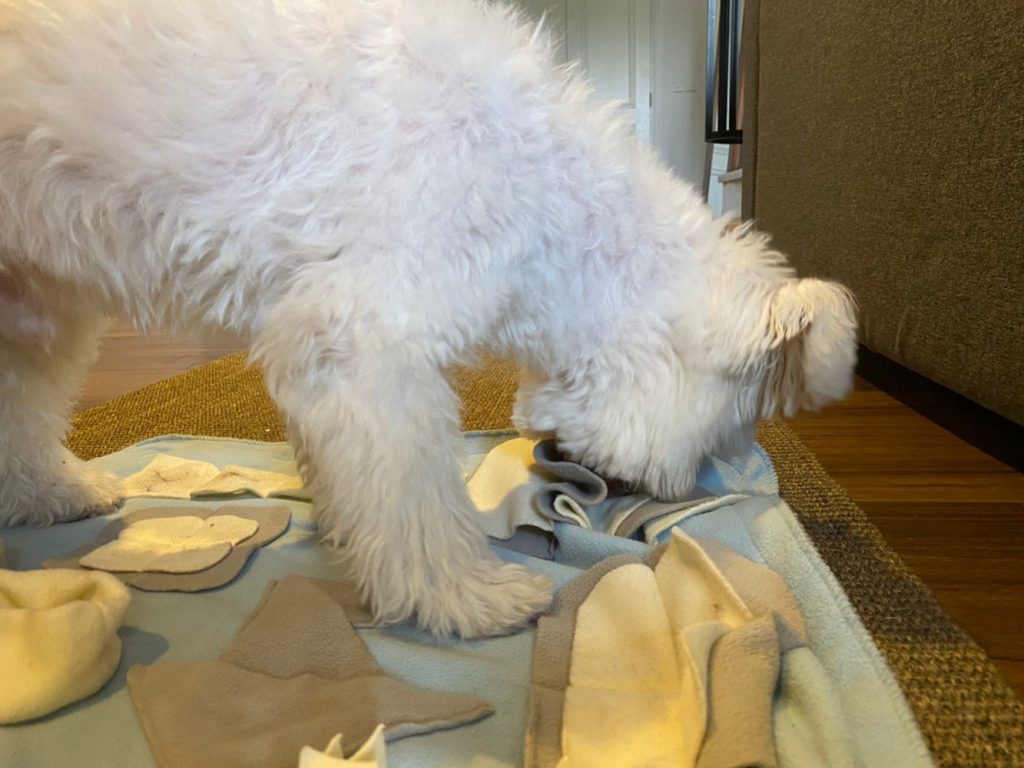It’s common knowledge that dogs need physical exercise to stay healthy and happy. What’s less known is that they also need mental stimulation and enrichment to live truly fulfilling lives. Enrichment activities engage your dog’s brain, encouraging them to think and focus, while physical exercise mainly works the body. To keep your dog physically, emotionally, and mentally content, it’s important to offer a balanced mix of both. Dogs who don’t get enough mental stimulation often find their own ways to stay busy, which can lead to behaviours owners see as unwanted. And don’t forget: rest is just as important. Downtime helps your dog process all the day’s activities, impressions, and lessons. So, what can you do to give your dog the mental workout they need?
Snuffle/Activity mat
Snuffle mats are a wonderful way to provide enrichment for your dog. They come in all shapes and sizes but share the same purpose: hiding treats for your dog to find. Sniffing and searching for those treats offers mental stimulation, encouraging your dog to use both their nose and problem-solving skills. Sniffing also helps relieve stress, and you can read more about this connection in our blog “The Importance of Sniffing”. For dogs that tend to eat too quickly, snuffle mats are also a great way to slow down mealtimes and support healthy digestion.

Dog Puzzle
Dog puzzles are interactive toys available in various difficulty levels. They encourage your dog to use their brain, paws, mouth, and nose to solve them. Because of the range in difficulty, you can choose a puzzle that suits your dog’s individual needs and skill level. Just like with human puzzles, it’s important to start at the right level to prevent frustration. Beginner puzzles help your dog understand the concept, and as they improve, you can gradually introduce more challenging ones.

Lick mat / Kong / Slow feeder / Treat ball
These tools make feeding time more interactive and fun. You can serve whole meals or parts of them in these items. Their design encourages your dog to work for their food, helping to slow down eating. Lick mats and Kongs also encourage licking, which releases endorphins in your dog’s brain and helps them feel calm and happy.
Lick mats, Kongs, slow feeders, and treat balls come in many sizes, shapes, and designs, allowing you to choose what best suits your dog’s needs. Many can also be adjusted in difficulty, for example some treat balls have adjustable openings, Kongs and lick mats can be frozen, and slow feeders come with both simple and more challenging layouts. Whatever you choose, start off easy to avoid frustration and help your dog build confidence.

Dog sports
Dog sports not only provide physical exercise but also offer great mental stimulation. There are many types to choose from, such as agility, hoopers, push/treibball, tracking, canine freestyle, and disc dog. Another benefit is that you can select a sport that suits your dog’s natural instincts and breed traits. For example, a Border Collie may particularly enjoy a herding-style sport like treibball.
Enrichment around the house and on walks
All of the activities mentioned above require some form of purchase, but you can also create plenty of enrichment opportunities using everyday items at home or things you find during walks. On walks, you can play sniffing or hide-and-seek games, or let your dog jump on and over natural obstacles such as rocks and branches (just watch out for sharp edges). Some dog parks even have agility equipment you can use. Another excellent option is a sniffari, a walk where you let your dog sniff as much as they like and follow their lead.
At home, you can make your own enrichment toys. Fill a cardboard box with shredded paper and hide treats inside, or put treats in a toilet paper roll and fold the ends closed. A plastic bottle with treats inside can serve as a homemade “treat ball.” You can also turn cups, flower pots, or small buckets upside down and hide treats or toys underneath for a fun DIY puzzle game.
Another great way to stimulate your dog’s mind is to scatter or hide their meal around the house or garden. Dogs love to forage and hunt for food, and this kind of activity satisfies that natural instinct. With a bit of creativity (and perhaps a quick Google search), you can come up with endless enrichment ideas. For more inspiration, check out our blog “11 DIY Enrichment Ideas for Your Dog.”
Dog enrichment
Enrichment is an important part of your dog’s daily routine. Providing it helps your dog feel happy, satisfied, and live a more fulfilling life. We hope this article has given you plenty of ideas to make their dogs’ lives more enriching. If you’d like more guidance, we offer special enrichment sessions as part of our dog training services. Our pet sitters and dog walkers also love seeing the furry friends they care for happy and content, and they incorporate enrichment activities whenever possible during their visits.
If you wish to know more about our pet sitting, overnight pet care, pet relocation or dog training services, feel free to contact us. We will be happy to help.

